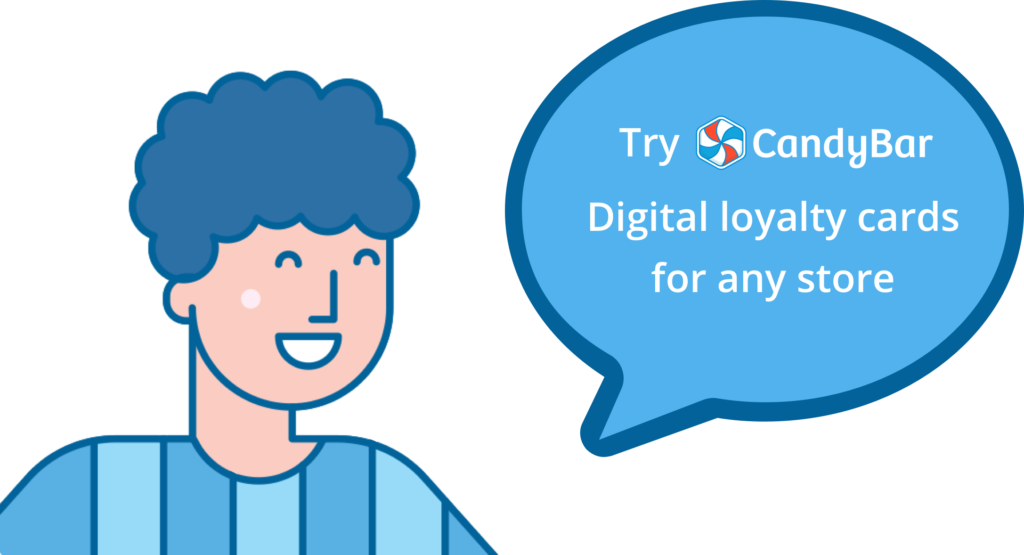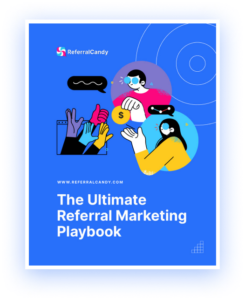Social media’s importance in the food and beverage industry is increasing. Why is that the case?
Sophie Ann Terrisse of the brand management firm, 26 FIVE explained it best:
It’s about people’s principles as a consumer rather than storytelling.
This creates a need for food and beverage professionals to use social media platforms to directly address consumers’ problems, rather than guessing what their struggles actually are.
It also creates a need for brands to avoid using social media for pushy sales pitches about how “great” their product is.
But why is that the case? Humans dedicate 30 to 40% of all speech to talking about themselves, and on social media that number jumps to 80% of all interactions.
Therefore, when they share a Facebook post, or refer your business to a friend consumers want to see a fragment of themselves in the products and services that they purchase on a daily basis.
However, pulling that off isn’t as complicated as it sounds. If you want your customers to see fragments of themselves in your online content, you need to personalize your posts based on not only your customers’ needs, but also the personalities and interests of your staff members.
How can you apply this approach to your business?
When you step into the shoes of the first-time buyer, you’ll realize that the most important part of their decision making process is finding value in what you’re promoting.
And that’s exactly what personalized content is all about.
Think about it:
- Why do you buy coffee from one store vs another?
- Why did you choose to visit one bar/restaurant over another during your nights out with friends?
Chances are it had something to do with:
- The people that work there
- And what it’s like to buy something from the staff, or take a seat at one of the tables.
And that’s the feeling that you want to capture, when post something new on social media.
But I’m already doing that! Why aren’t my social media posts making an impact?
Here are some of the most common mistakes food and beverage pros make with their social media marketing.
Don’t worry though, these mistakes are 100% fixable.
1. You are not consistent
Do you only post when…
- Inspiration strikes?
- You have something to share about your customer review/ loyalty program?
- Or you have an honorable press mention to share?
If that sounds like you, that’s likely what is causing factors such as:
- Low engagement levels
- A low follower count
- A lack of interest in your social media content
In fact, according to the 2016 SproutSocial Q3 index:
75% of survey participants purchased a product because they saw it on social media. Yet, 60.5% of participants said they had to see posts 2-4 times before making purchasing decisions.
If you want to make an impact, you need to post consistently. You can post manually or make use of apps – you can check out this list of paid and free social media posting tools to find one that suits your restaurant.
But how effective is consistency?
To sum up why consistency is important, here’s a story of how Olive Garden saved themselves during the 2008 American financial crisis by posting consistently.
Because Americans ate out less during the financial crisis to save money, Olive Garden struggled to survive.
Instead of letting tough times define them, they got to know their audience a bit better.
The company learned that a large percentage of their customers are Millennials. They also learned that their customers respond positively to companies that are active on social media platforms.
So that’s when Olive Garden decided to prioritize social media marketing.
And the results?
11 straight quarters of sales growth, and stock prices were at an all-time high.
How Olive Garden maintains the authenticity of their content
Olive Garden publishes social media content that embraces their family values:
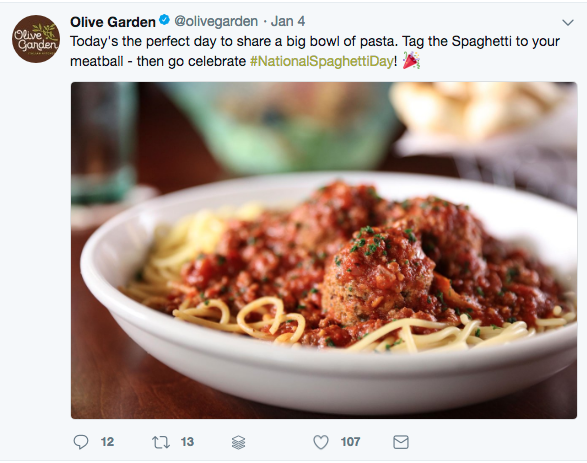
Although they don’t post new tweets every day, they post something new every two to three days.
Because the tone and schedule of their content is consistent, they’ve established a loyal, online group of followers.
(RELATED: Learn from Boufe Boutique Cafe’s social media strategy here.)
2. Not posting at the right time
Sometimes the problem isn’t what you’re posting. It might be the timing of your content. Timing is everything when it comes to all types of content marketing.
Here’s why:
If you want to schedule an important meeting, and the attendees aren’t morning people, scheduling an 8am start time probably won’t result in a productive meeting. If you want to book a cheap vacation, you probably shouldn’t book it during the holidays.
The same rule applies to social media content as well, because everything you post is about finding the right context and the right solution to customers’ most common problems.
How timing of your social media content can benefit your company:
Nestle is a great example of a company that has thrived off getting the timing of their social media content on-par with customer struggles and priorities.
Their brand is hundreds of years old but that doesn’t stop them from staying relevant in a digital-focused world, through quick, social media-based responses to customer feedback.
So…what’s their secret?
Nestle’s secret weapon is DAT (the Digital Acceleration Team) who train employees on the digital side of business. They also experiment with new, digital trendsetting techniques, in order to find new and unique approaches to content marketing.
And it’s the hard work of the DAT team that allows the entire Nestle team to keep their eyes and ears on what their customers are actually interested in.
For example, here’s how the company responded when #wholegrain was a trending topic:
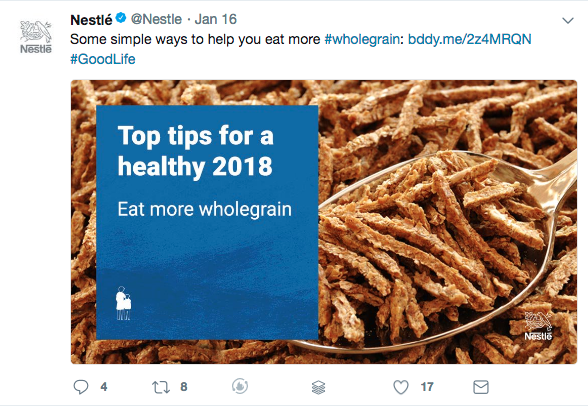
Because Nestle joined a trending discussion, they increased the impact of their tweet about their blog post on healthy eating.
But I know what you’re thinking:
Nestle is a major corporation. We can’t afford to make that level of investment!
However, this quote from the CMO of Nestle, Peter Bradshaw demonstrates how the company’s marketing strategy actually works:
The best and brightest come to our headquarters for eight months at a time for pure training and doing work on digital. It’s about 11 marketers at a time, and they execute projects by listening and engaging.
Investing in digital marketing-focused training for your company will allow staff members to take the feedback that they get from their customers in-person, and turn it into social media content that provides timely solutions.
It will also help your team provide quicker responses to social media-based, customer concerns. Because no response signals to the customer that you don’t care about their needs.
3. Not posting on the right platform
Often food and beverage business owners assume that setting up a social media account on any, popular platform attract customers.
However, social media isn’t a “one-size fits all” concept, and the popularity of a platform doesn’t make it the right fit for your restaurant.
For example, Fractl and Buzzstream conducted a study, which concluded that Facebook is:
- A male-dominated, college educated platform
- And a high percentage of the users have an IT-related job.
But it’s important to keep in mind that the study featured audience insights from platforms such as Buzzfeed and Huffington Post.
Yet, it still says something important about why knowing your audience is important.
Because if Facebook marketing it isn’t leading to anything valuable, you might be targeting the wrong demographic.
This is also the case with other social media platforms as well.
So… how do you know what the right fit is for you?
Create a survey, and get your customers to fill it out.
In the survey, feature questions that encourage customers to:
- Share what they’re interested in/ what they like best about your company
- Talk about what their favourite social media platforms are
- Reveal demographic information such as their education, age, occupation, etc.
- Discuss what they’d like to see more of from your company
Then, use what you learned to inform future content, and prioritize two to three of the most popular social media accounts amongst your customers.
Not only will your survey help you uncover valuable info about your customers, but it will also increase customer satisfaction over the long-term.
In fact, a Harvard Business Review study revealed that surveys appeal to people’s desires to be coddled, while increasing customer awareness of a company’s products, which encourages future purchases.
4. You’re not using your social media accounts as a relationship-building tool
Setting up a social media account for your business is a step in the right direction.
However, the impact of your social media platforms will be a lot stronger if you include a principle called “social selling” in your content marketing strategy.
So…what is social selling? According to Hootsuite social selling is:
The art of using social networks to find, connect, and nurture sales prospects. It’s the modern way to develop meaningful relationships with potential customers that keep you, and your brand front of mind.
If you truly want to make your social media marketing a worthwhile investment for your company…
You need to make an effort to offer valuable solutions to potential customers’ problems on your social media networks, and also on platforms such as Quora and Reddit.
Because online, community forums are a useful tool. In fact, 79.2% of forum contributors help friends or family make a decision about a product purchase.
The most appropriate time to participate in these forums is when people are struggling with, or have a question about something that:
- Your products can solve
- You’re in expert in, which directly relates to the products that you sell.
For example, here’s how a coffee sales exec answered a forum user’s question about how to use the Keurig Coffee Maker to make the brew stronger and less watery, with a reusable cup:
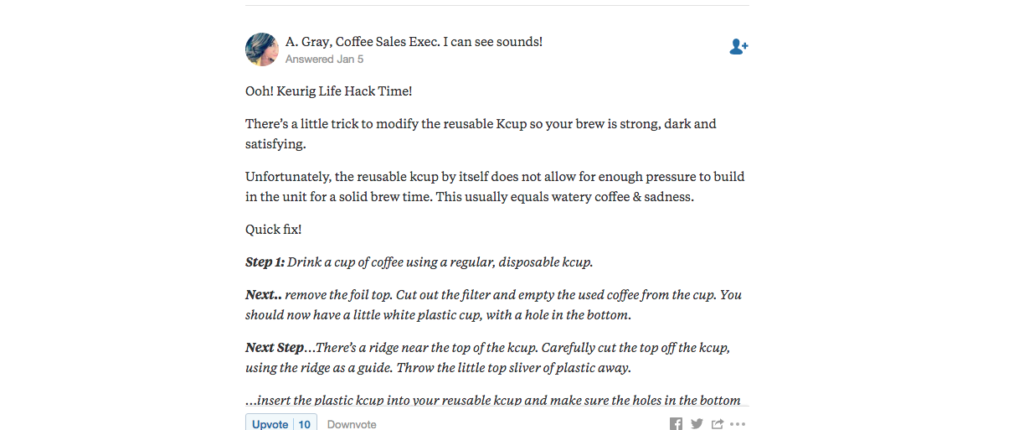
The coffee sales exec took a potential customer’s concern about how the product that they want to know more about works, and used it as an opportunity to help someone out for free.
Notice how this isn’t a sales pitch, and she didn’t provide any promo links?
Because this wasn’t just another sales pitch, the Quora user who asked that question will be much more likely to purchase the Keurig coffee maker in the future.
But what will inform their decision? They’ll know exactly how to make the Keurig coffee maker produce results that appeal to their own, unique tastes in coffee.
If you’re not getting enough followers, and no one is clicking on or sharing your links, offering advice to the people you want to reach can make a huge impact.
And if you’re reading this and thinking to yourself: “but I’m too busy for that” here’s something that you need to keep in mind:
Answering a potential customer’s question about your products takes just as much time as a Facebook status update.
Not to mention, the payoff is significant. In fact, customers are a lot more likely to trust brands who are helpful than those who are not.
5. Tying up with the wrong influencers
Trying the right approach matters
Often, it’s not the overall impact of social media that’s a problem. It’s how you’re approaching your content marketing strategy.
If your current approach doesn’t work, you can always try something new. Because finding the right platform and publishing the right content is a trial and error-based process.


